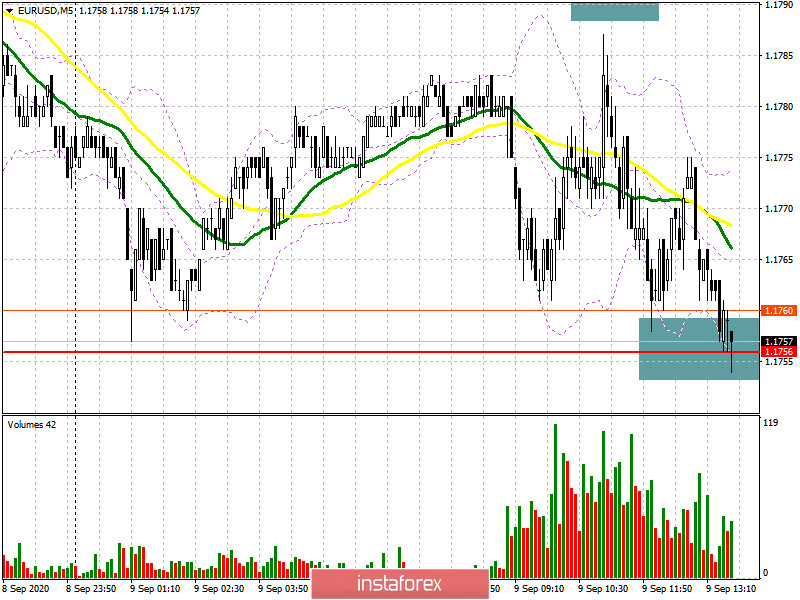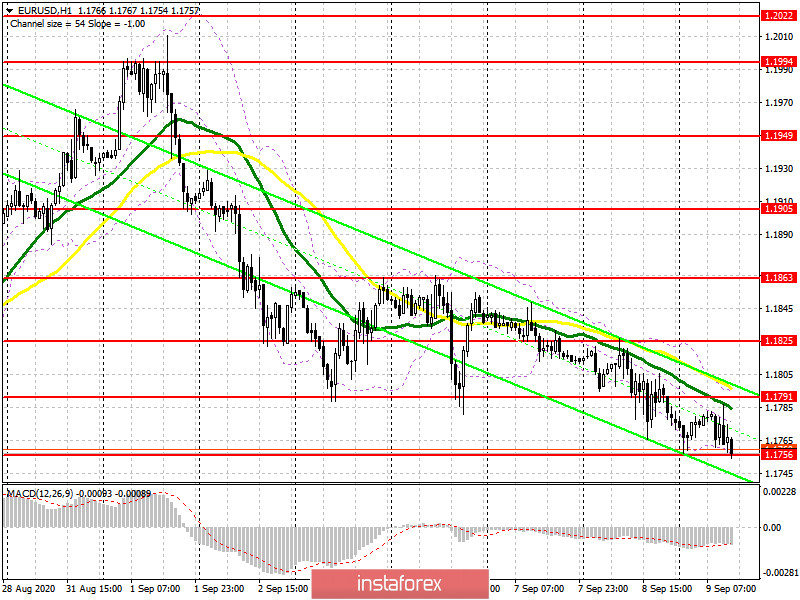To open long positions on EURUSD, you need:
I paid attention to the protection of the support level of 1.1756 in my morning forecast, as its breakdown will lead to a very strong fall in the euro. Moreover, we did not wait for the resistance test of 1.1791, from which I recommended opening short positions. The pair did not reach this level by just 5 points. Now the bulls need to save the support of 1.1756 and the formation of a false breakout on it with a return to this level closer to the second half of the day will be a signal to open long positions. In the absence of activity and rapid growth of the pair from this range, it is best to postpone purchases until the minimum of 1.1714 is updated or open long positions immediately for a rebound from the support of 1.1648 in the expectation of a correction of 20-30 points within the day. To stop the downward momentum, the bulls also need to return to the resistance of 1.1791, which will lead to the demolition of a number of bears' stop orders and a larger recovery of EUR/USD to the resistance area of 1.1825, where I recommend fixing the profits.

To open short positions on EURUSD, you need:
Given that important fundamental statistics are not expected to be released in the second half of the day, it is possible that pressure on the euro will continue before tomorrow's meeting of the European Central Bank on interest rates. The task of the bears is still to break through and consolidate under the support level of 1.1756, which forms a new entry point for short positions in the expectation of a decline in EUR/USD to the area of the minimum of 1.1714, where I recommend fixing the profits. Persistent sellers will wait for the update of the support of 1.1648. However, if there is no active decline in the pair after fixing below 1.1756, it is better to abandon short positions. An equally important task and an additional entry point for selling the euro will be to protect the resistance of 1.1791, which buyers have not reached today. The formation of a false breakout there will lead to another wave of decline in the European currency. Otherwise, it is better to wait for sales and wait for the test of a larger resistance of 1.1825, based on a correction of 20-30 points within the day.

Signals of indicators:
Moving averages
Trading is conducted below the 30 and 50 daily moving averages, which indicates that the bears are trying to continue the downward movement of the market.
Note: The period and prices of moving averages are considered by the author on the hourly chart H1 and differ from the general definition of classic daily moving averages on the daily chart D1.
Bollinger Bands
A break of the lower limit of the indicator in the area of 1.1755 will increase the pressure on the euro. A break of the upper limit of the indicator in the area of 1.1791 will lead to the growth of the pair.
Description of indicators
- Moving average (moving average determines the current trend by smoothing out volatility and noise). Period 50. The graph is marked in yellow.
- Moving average (moving average determines the current trend by smoothing out volatility and noise). Period 30. The graph is marked in green.
- MACD indicator (Moving Average Convergence / Divergence - moving average convergence / divergence) Fast EMA period 12. Slow EMA period 26. SMA period 9
- Bollinger Bands (Bollinger Bands). Period 20
- Non-profit speculative traders, such as individual traders, hedge funds, and large institutions that use the futures market for speculative purposes and meet certain requirements.
- Long non-commercial positions represent the total long open position of non-commercial traders.
- Short non-commercial positions represent the total short open position of non-commercial traders.
- Total non-commercial net position is the difference between the short and long positions of non-commercial traders.





















